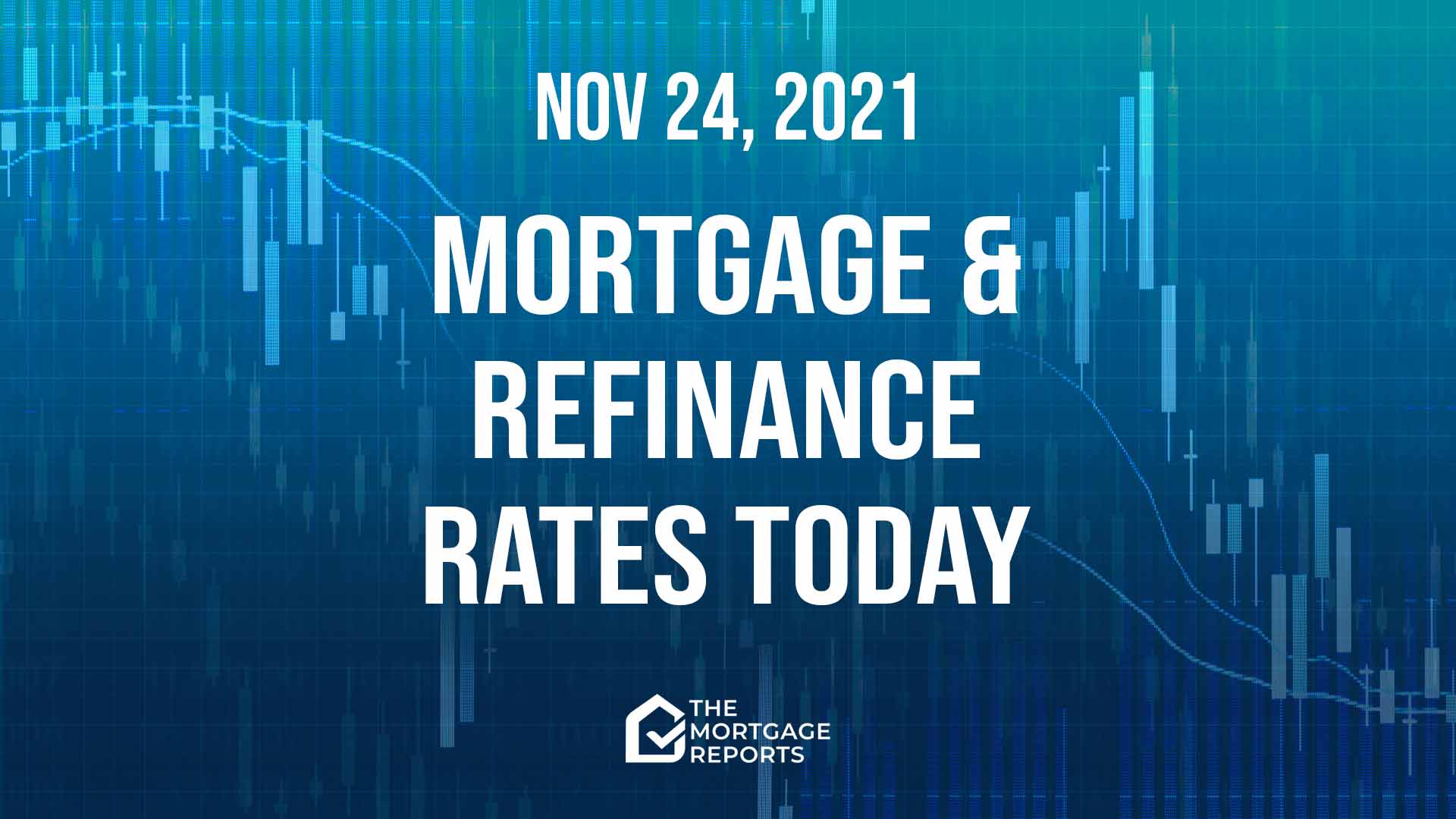
Today’s mortgage and refinance rates
Average mortgage rates nudged higher yesterday, taking them to their highest point in several months. Still, they remain incredibly low by pre-pandemic standards.
It’s looking as if mortgage rates today might rise modestly, buoyed by good figures earlier for weekly unemployment claims, and durable goods orders. However, other information due out later (see below) could change everything.
Happy Thanksgiving tomorrow! We’ll be back on Friday.
Find your lowest rate. Start here (Nov 24th, 2021)Current mortgage and refinance rates
| Program | Mortgage Rate | APR* | Change |
|---|---|---|---|
| Conventional 30 year fixed | |||
| Conventional 30 year fixed | 3.423% | 3.442% | +0.08% |
| Conventional 15 year fixed | |||
| Conventional 15 year fixed | 2.775% | 2.804% | +0.03% |
| Conventional 20 year fixed | |||
| Conventional 20 year fixed | 3.279% | 3.313% | +0.06% |
| Conventional 10 year fixed | |||
| Conventional 10 year fixed | 2.76% | 2.818% | +0.03% |
| 30 year fixed FHA | |||
| 30 year fixed FHA | 3.461% | 4.228% | +0.06% |
| 15 year fixed FHA | |||
| 15 year fixed FHA | 2.721% | 3.367% | +0.01% |
| 5/1 ARM FHA | |||
| 5/1 ARM FHA | 2.639% | 3.235% | +0.02% |
| 30 year fixed VA | |||
| 30 year fixed VA | 3.283% | 3.479% | +0.02% |
| 15 year fixed VA | |||
| 15 year fixed VA | 2.955% | 3.299% | +0.1% |
| 5/1 ARM VA | |||
| 5/1 ARM VA | 2.6% | 2.423% | +0.02% |
| Rates are provided by our partner network, and may not reflect the market. Your rate might be different. Click here for a personalized rate quote. See our rate assumptions here. | |||
Should you lock a mortgage rate today?
There’s little sign yet of mortgage rates falling in response to higher daily COVID-19 infections.
So, for now, my personal rate lock recommendations remain:
- LOCK if closing in 7 days
- LOCK if closing in 15 days
- LOCK if closing in 30 days
- LOCK if closing in 45 days
- LOCK if closing in 60 days
>Related: 7 Tips to get the best refinance rate
Market data affecting today’s mortgage rates
Here’s a snapshot of the state of play this morning at about 9:50 a.m. (ET). The data, compared with roughly the same time yesterday, were:
- The yield on 10-year Treasury notes climbed to 1.68% from 1.65%. (Bad for mortgage rates.) More than any other market, mortgage rates normally tend to follow these particular Treasury bond yields
- Major stock indexes were lower soon after opening. (Good for mortgage rates.) When investors are buying shares they’re often selling bonds, which pushes prices of those down and increases yields and mortgage rates. The opposite may happen when indexes are lower. But this is an imperfect relationship
- Oil prices edged down to $78.47 from $78.55 a barrel. (Neutral for mortgage rates*.) Energy prices play a large role in creating inflation and also point to future economic activity.
- Gold prices inched lower to $1,783 from $1,790 an ounce. (Neutral for mortgage rates*.) In general, it is better for rates when gold rises, and worse when gold falls. Gold tends to rise when investors worry about the economy. And worried investors tend to push rates lower
- CNN Business Fear & Greed index — nudged down to 57 from 60 out of 100. (Good for mortgage rates.) “Greedy” investors push bond prices down (and interest rates up) as they leave the bond market and move into stocks, while “fearful” investors do the opposite. So lower readings are better than higher ones
Caveats about markets and rates
Before the pandemic and the Federal Reserve’s interventions in the mortgage market, you could look at the above figures and make a pretty good guess about what would happen to mortgage rates that day. But that’s no longer the case. We still make daily calls. And are usually right. But our record for accuracy won’t achieve their former high levels until things settle down.
So use markets only as a rough guide. Because they have to be exceptionally strong or weak to rely on them. But, with that caveat, mortgage rates today look likely to rise a little. But be aware that “intraday swings” (when rates change direction during the day) are a common feature right now.
Find your lowest rate. Start here (Nov 24th, 2021)Important notes on today’s mortgage rates
Here are some things you need to know:
- Typically, mortgage rates go up when the economy’s doing well and down when it’s in trouble. But there are exceptions. Read ‘How mortgage rates are determined and why you should care
- Only “top-tier” borrowers (with stellar credit scores, big down payments and very healthy finances) get the ultralow mortgage rates you’ll see advertised
- Lenders vary. Yours may or may not follow the crowd when it comes to daily rate movements — though they all usually follow the wider trend over time
- When daily rate changes are small, some lenders will adjust closing costs and leave their rate cards the same
- Refinance rates are typically close to those for purchases. And a recent regulatory change has narrowed a gap that previously existed
So a lot is going on here. And nobody can claim to know with certainty what’s going to happen to mortgage rates in coming hours, days, weeks or months.
Are mortgage and refinance rates rising or falling?
After all the ups and downs of the last four weeks, mortgage rates last night were only a little higher than they were at the start of that period, according to Mortgage News Daily’s archive. But MND says they’re starting this morning at their highest point since April.
So, overall, they’re gently drifting higher. However, as you’d expect, there have been plenty of periods when they’ve fallen a little. Unfortunately, those tend to be relatively brief, shallow and unpredictable. So my rate lock recommendations have been stuck on “lock” for some months.
Today
Yesterday, I talked about a small avalanche of market-sensitive information” due out today. Overnight, The Guardian called it a “tsunami.” Take your pick.
The Fed will be releasing at 2 p.m. (ET) the minutes of the last meeting of its monetary policy body, the Federal Open Market Committee. And investors will pore over those for hints about future rate hikes. If they find any of those, mortgage rates might rise.
This morning also brings figures for gross domestic product (GDP) in the third quarter of this year. That sounds very important and it could be. But we’ve already had the first reading of those figures and few expect much to have changed since those came out.
It’s more likely that this morning’s core personal consumption expenditures, out at 10 a.m. (ET), will move markets and mortgage rates. That’s the core inflation measure that the Fed pays most attention to. Analysts polled by MarketWatch expect a year-over-year rise of 4.1%. But, if it’s appreciably higher than that, mortgage rates might rise.
Skeleton staff
Tomorrow is, of course, Thanksgiving. And bond markets will be closed both that day and on Friday afternoon.
Many who influence markets may extend their breaks by taking extra days today and on Friday morning. So we may have fewer and less experienced people determining mortgage rates and bond yields.
That could go one of two ways. They might be more active to show their absent bosses how capable they are. Or they might play things safe and barely react to news. Past holidays provide little guidance as to which way they’ll go this time.
Further ahead
Overall, I still expect mortgage rates to climb higher. However, there’s a real possibility of a new wave of COVID-19 pulling them lower over the winter. How likely that is remains anyone’s guess. Read more about that in Monday’s edition of that article.
You can also read last Saturday’s weekend edition for more general background.
Recently — Updated today
Over much of 2020, the overall trend for mortgage rates was clearly downward. And a new, weekly all-time low was set on 16 occasions last year, according to Freddie Mac.
The most recent weekly record low occurred on Jan. 7, when it stood at 2.65% for 30-year fixed-rate mortgages.
Since then, the picture has been mixed with extended periods of rises and falls. Unfortunately, since September, the rises have grown more pronounced, though not consistently so.
Freddie’s Nov. 24 report puts that weekly average for 30-year, fixed-rate mortgages at 3.1% (with 0.7 fees and points), unchanged from the previous week.
Expert mortgage rate forecasts
Looking further ahead, Fannie Mae, Freddie Mac and the Mortgage Bankers Association (MBA) each has a team of economists dedicated to monitoring and forecasting what will happen to the economy, the housing sector and mortgage rates.
And here are their current rate forecasts for the remaining, current quarter of 2021 (Q4/21) and the first three quarters of 2022 (Q1/22, Q2/22 and Q3/22).
The numbers in the table below are for 30-year, fixed-rate mortgages. Fannie’s were published on Nov. 18 and the MBA’s on Nov. 22.
Freddie’s were released on Oct. 15. It now updates its forecasts only quarterly. So we may not get another from it until January.
| Forecaster | Q4/21 | Q1/22 | Q2/22 | Q3/22 |
| Fannie Mae | 3.1% | 3.2% | 3.3% | 3.3% |
| Freddie Mac | 3.2% | 3.4% | 3.5% | 3.6% |
| MBA | 3.1% | 3.3% | 3.5% | 3.7% |
However, given so many unknowables, the whole current crop of forecasts may be even more speculative than usual.
All these forecasts expect at least modestly higher mortgage rates fairly soon.
Find your lowest rate today
Some lenders have been spooked by the pandemic. And they’re restricting their offerings to just the most vanilla-flavored mortgages and refinances.
But others remain brave. And you can still probably find the cash-out refinance, investment mortgage or jumbo loan you want. You just have to shop around more widely.
But, of course, you should be comparison shopping widely, no matter what sort of mortgage you want. As federal regulator the Consumer Financial Protection Bureau says:
Shopping around for your mortgage has the potential to lead to real savings. It may not sound like much, but saving even a quarter of a point in interest on your mortgage saves you thousands of dollars over the life of your loan.
Verify your new rate (Nov 24th, 2021)Mortgage rate methodology



